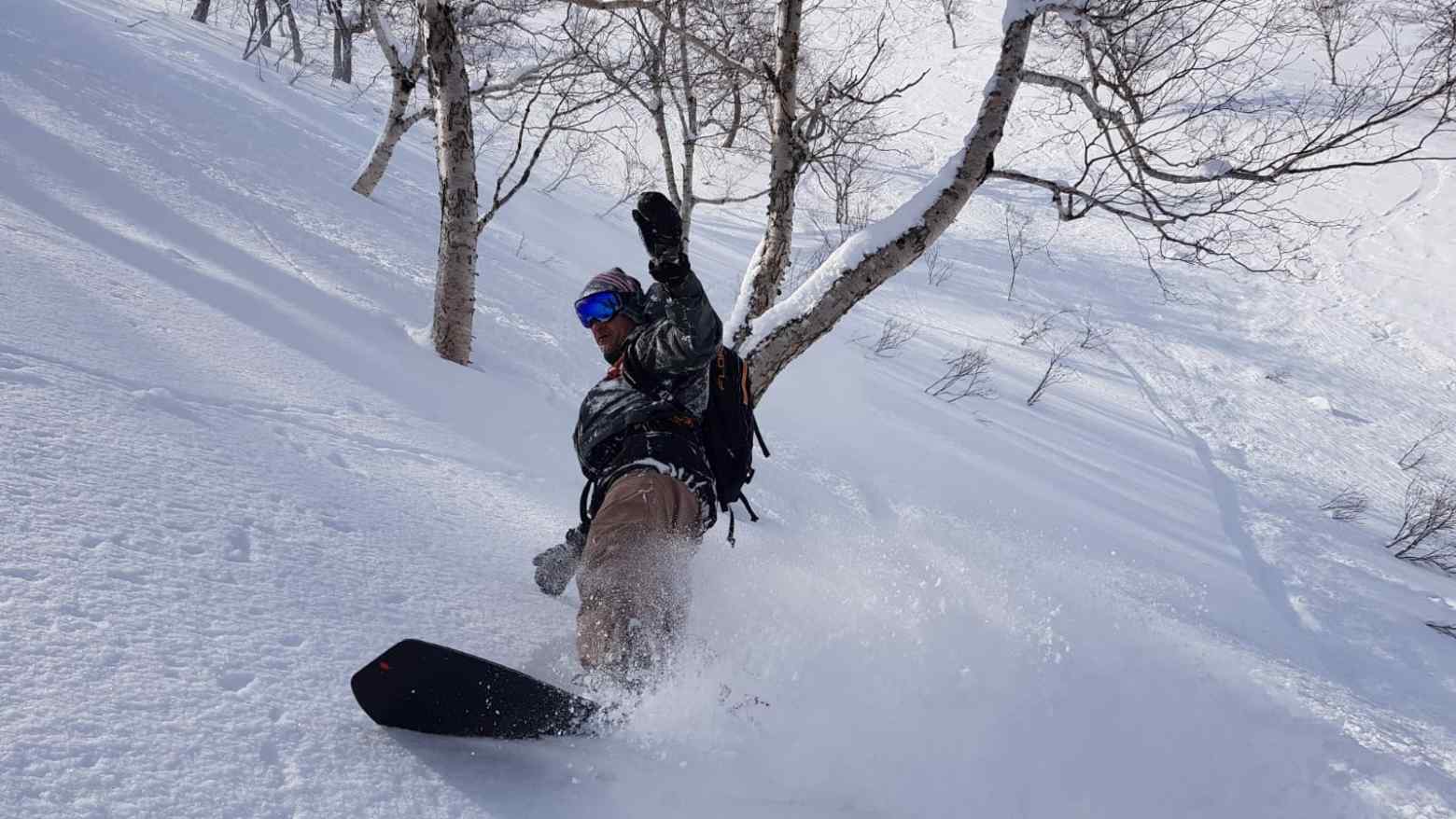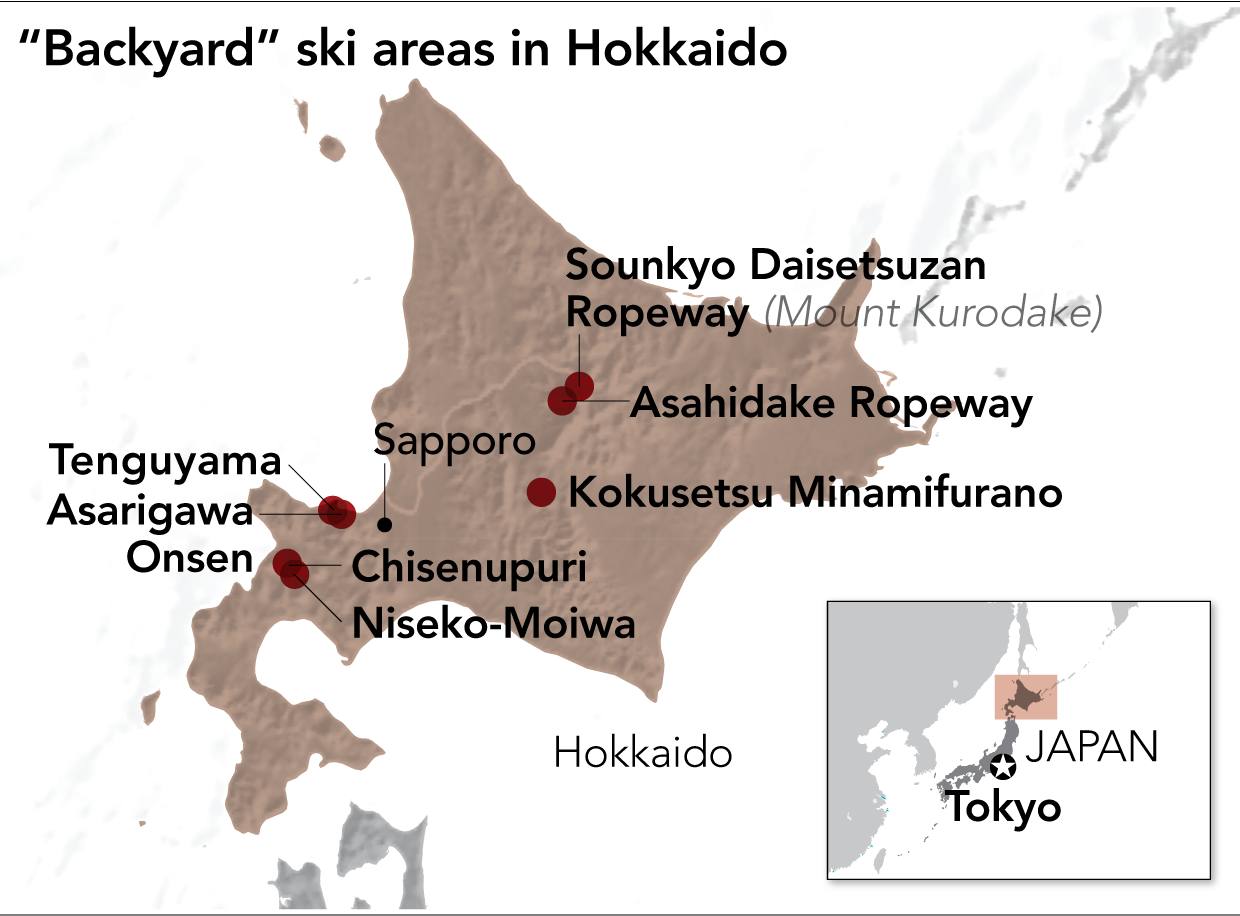Nikkei Asia-Skiing Hokkaido’s Hidden Gems
Pursuing forgotten powder trails in Hokkaido's 'backyard' ski areas
Japan's small resorts are exploring ways to survive depopulation

A snowboarder carves through fresh powder off the beaten path, with the help of the Hokkaido Backcountry Club's ski tour services. (Photo by Amy Chavez)
AMY CHAVEZ, Contributing writer
December 29, 2024 09:00 JST
HOKKAIDO, Japan -- It is every skier's dream, cutting through knee-deep powder in virgin, untracked snow. I float down the mountain smiling, whooping and bouncing from one turn to the next in a rhythmic trance. At the bottom of the slope I feel exhilarated, ready to go back up for more.
Hokkaido's international ski resorts, such as Niseko United and Furano, draw crowds from around the world to their special light powder snow, known as JaPow. But many smaller ski areas are struggling to survive as Japan's population ages and declines. At least 25% of resorts have disappeared since the early 1990s.
During winter 2024, my partner and I rented a car to access a handful of "backyard" ski hills in Hokkaido to find out how they were faring. What we found was surprising: Japan's smaller regional slopes are under pressure, but are adapting in some unusual ways.
We picked up our rental vehicle next to JR Furano train station and drove 40 kilometers south to Minamifurano, population 2,254. The Kokusetsu Minamifurano ski area is a nationally established facility that was part of a government plan implemented in the 1960s to revitalize small villages and promote tourism. Masahiro Koshiba is a product of the system.
"My parents didn't have the opportunity to learn to ski when they were young, but when Minamifurano opened, the elementary and junior high schools started offering skiing as [physical education] classes," he said. "Me and my siblings all learned to ski here."


In what can only be described as retro pricing, we paid just 1,500 yen ($9.76) each for a 4-hour ticket to ride two ancient chairlifts: one single-seat and the other a rickety double that carried us up 220 vertical meters. We shared the mountain with just one other skier. The cafeteria was a one-woman operation, open from 11 a.m. to 1:30 p.m.
Nakamura Fujio, head of Minamifurano Promotion, which oversees the management of the ski center, said he was optimistic about its sustainability. "Because the schools have used it, everyone wants their hometown slope to stay open," he told me -- a poignant reminder that without youth programs, the sport has no future.
The first ski areas in Japan were farming cooperatives that jointly opened ski hills, sometimes with the backing of municipalities. Different lift companies would band together to install lifts on the same hill, after which they could manage them jointly. When universities and companies started ski clubs, a ski boom was born.
The 1972 Sapporo Winter Olympics fueled the nascent sport, and another ski boom followed in the late 1980s, sparked by a 1987 film called "Watashi wo Sukii ni Tsuretette" ("Take Me Skiing With You"), a romantic movie that follows a couple on weekend ski trips. By the 1990s, skiing was the most popular sport for young, single Japanese.


Winter mists hang over the Hokkaido town of Furano. (Photo by Amy Chavez)
Next, we drove three hours west to Otaru to check out two neighboring ski hills: Tenguyama and Asarigawa Onsen, both offering more than just skiing and snowboarding. Tenguyama, with five runs and a vertical drop of 410 meters, is popular for its tramway, which carries both skiing and nonskiing tourists to the peak of Mount Tengu in about four minutes. The mountain takes its name from the tengu goblin said to live there, a form of yokai (spirit creature) who is identifiable by his cape and fire engine-red nose.
After exiting the tram car, visitors come to a shrine in the forest dedicated to the supernatural creature, where they can pray for protection and fortune. In the same building as the cafeteria, which offers a panoramic vista over Otaru city and the Sea of Japan, is the Tengu House, a heritage exposition that includes a replica of the local yokai and over 700 tengu masks from around Japan.
There is also a ski museum, where we learned that in 1908, a Swiss citizen named Hans Koller who taught German at Hokkaido University introduced his students to skiing. Because he could not find a suitable language textbook for German, Koller used a skiing primer instead. After learning the theory, the students naturally wanted to put it into practice, which earned them the honor of being the first recreational Hokkaido skiers.

 Top: Hokkaido mountain vista. (Getty Images) Bottom: Over 700 tengu (goblin) masks are displayed at Tengu House in Otaru. (Photo by Amy Chavez)
Top: Hokkaido mountain vista. (Getty Images) Bottom: Over 700 tengu (goblin) masks are displayed at Tengu House in Otaru. (Photo by Amy Chavez)
We spent our second morning skiing untracked powder at Asarigawa Onsen ski field located above a hot-spring hamlet of the same name. The cluster of hotels ensures skiers and snowboarders the luxury of soaking their tired muscles in steamy water at the end of the day. But we were not prepared for the long climb up to the ski area from the parking lot. Halfway up, we were rescued by the waku-waku, a conveyor belt on which skiers stand, holding their skis as it carries them up to the ticket office.
Leaving Otaru, we backtracked to central Hokkaido's Daisetsuzan National Park to visit two mountains that offer an adventure different from the ski resort experience.
The town of Kamikawa is popular among summer tourists who come to hike, ogle its waterfalls, experience its chain of gorges and ride the 1,650-meter-long Sounkyo Daisetsuzan Ropeway, which rises 629 meters up Mount Kurodake. This summer tramway is closed for most of the winter, but reopens in February or March (depending on the year) to take skiers, snowboarders and camera-slinging tourists to the top.

In addition, high winds and severe winter storms may render it impossible to operate the ropeway. Although we delayed our trip to coincide with the mid-February opening, we still had to wait three days for the weather gods to bestow kindness. In the meantime, we hunkered over coffee in the smart cafe in the ropeway station at the bottom, walked among the wild deer milling around the village, took in the Sounkyo Ice Waterfall Festival at night and soaked in the natural hot springs at our hotel.
On the fourth day, we finally ascended the mountain where, from the top ropeway station, we walked another 100 meters with our skis over our shoulders to the chairlift. The lone lift provides access to a gentle slope for beginners, with more challenging terrain in the trees alongside. An alternative option is to set off into the backcountry wilderness with a ski guide to take you down the steeper parts of Mount Kurodake.
Just across the range is the Asahidake Ropeway, another summer attraction that allows winter sports access. At 2,291 meters, Asahidake is Hokkaido's tallest mountain. An active stratovolcano, the mountain has numerous fumaroles that send clouds of white plumes rolling up from the piste, which makes for intriguing photographs.
 Fumarole plumes on Asahidake, Hokkaido's tallest mountain. Skiers can be seen in the foreground. (Photo by Amy Chavez)
Fumarole plumes on Asahidake, Hokkaido's tallest mountain. Skiers can be seen in the foreground. (Photo by Amy Chavez)
Asahidake is a backcountry ski area heavy on expert terrain. It offers two lengthy, groomed intermediate-expert courses but anyone skiing off-piste for the powder should ski with a guide who knows the mountain's geothermal features. Avalanche gear is required. There is no ski patrol; only mountain rescue, the full cost of which is borne by victims.
By now a few weeks had passed, and we pointed our rental car southwest to Niseko. Adjacent to the renowned Niseko United Ski Resort, an independent ski area named Moiwa has rebranded itself as Niseko-Moiwa to reflect its position in the famed 200-km-wide Niseko region. With only three chairlifts, including one designated for beginners, it is hard to imagine how this quiet, backyard ski field can stand up to the formidable local competition.
Masaya Yoshimura, general manager for 20 years, moved to Moiwa in 1999. "Overall, there has been a 25% decrease in demand for skiing," said Yoshimura, referring to the shrinking domestic skier market. But because Niseko-Moiwa is owned by several corporations, "big investment is in the works," he tells me. "The pair lift (a two-seater chairlift) will be swapped out for a four-seater to double capacity to the top of the slope, and the existing quad-chair will be replaced with a gondola."
The resort plans to attract young local skiers by providing a snowboard park, offering ski and snowboard camps, and staging snow sports events. "We've tried a lot of things and are now at the point where we can outsource these events, which has led to more professional offerings and production," Yoshimura said.
 Left: Snack break at the Niseko-Moiwa ski area. Right: Masaya Yoshimura has been the general manager of Niseko-Moiwa for 20 years. (Photos by Amy Chavez)
Left: Snack break at the Niseko-Moiwa ski area. Right: Masaya Yoshimura has been the general manager of Niseko-Moiwa for 20 years. (Photos by Amy Chavez)
The resort harbors another strategy too: increasing prices. "We need to raise our prices so we can provide a better product," Yoshimura said. "Moiwa has always been known for its large dumps of powder and lack of crowds. We aim to be exclusive. People come here for their own powder. They don't have to share it with crowds like at the big international resorts."
Our alpine adventure ended in Niseko, where Clayton Kernaghan, the Canadian owner of the Hokkaido Backcountry Club, a ski tour company, is repurposing land from former ski areas. HBC leases four runs from the Chisenupuri ski area, closed since 2012, on which they transport groups of up to 12 intermediate to advanced skiers and riders in a "snow cat" vehicle -- equipped with tracks -- to the top.
 The Hokkaido Backcountry Club, owned by Canadian Clayton Kernaghan, offers heli-skiing tours. (Hokkaido Backcountry Club)
The Hokkaido Backcountry Club, owned by Canadian Clayton Kernaghan, offers heli-skiing tours. (Hokkaido Backcountry Club)
Kernaghan said he considers cat skiing tours (and the company's heli-skiing tours) a further opportunity to revitalize the small towns connected to these lands. In the town of Shimamaki near the Sea of Japan, where HBC offers another cat skiing tour, it sources provisions and puts up customers in local accommodations.
"Right now, 5% of our sales [revenues] go to Shimamaki town. We aim to increase that to 10%, but to do that we need more terrain," said Kernaghan, adding that he is actively seeking to expand. "Then we'd be doubling fuel purchases, food, number of accommodations, etc., and the town would make more money."
Our day of skiing with HBC concluded with souvenirs from the local town. When I inquired about who arranged these gifts, Kernaghan said HBC buys them as keepsakes for its customers.
Amy Chavez is author of "The Widow, The Priest and the Octopus Hunter: Discovering a Lost Way of Life on a Secluded Japanese Island."
Where to Stay
Niseko-Moiwa: The Lodge Moiwa 834 (across from the lift)
Minamifurano: Log Hotel Larch (on Lake Kanayama)
Kurodake ski area: Sounkaku hotel (across from the ropeway)
Asahidake ski area: Hotel Bearmonte (walking distance to the ropeway)
Otaru Tenguyama and Asarigawa Onsen: Otaru city. Local bus to the ski areas (ski/snowboard bags are required for transporting equipment)
Niseko: SnowDog Village, Higashiyama